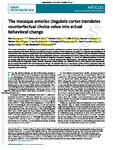The macaque anterior cingulate cortex translates counterfactual choice value into actual behavioral change
| dc.contributor.author | Fouragnan, Elsa | |
| dc.contributor.author | Chau, BKH | |
| dc.contributor.author | Folloni, D | |
| dc.contributor.author | Kolling, N | |
| dc.contributor.author | Verhagen, L | |
| dc.contributor.author | Klein-Flügge, M | |
| dc.contributor.author | Tankelevitch, L | |
| dc.contributor.author | Papageorgiou, GK | |
| dc.contributor.author | Aubry, J-F | |
| dc.contributor.author | Sallet, J | |
| dc.contributor.author | Rushworth, MFS | |
| dc.date.accessioned | 2019-04-17T11:47:10Z | |
| dc.date.available | 2019-04-17T11:47:10Z | |
| dc.date.issued | 2019-05 | |
| dc.identifier.issn | 1097-6256 | |
| dc.identifier.issn | 1546-1726 | |
| dc.identifier.uri | http://hdl.handle.net/10026.1/13724 | |
| dc.description.abstract |
The neural mechanisms mediating sensory-guided decision-making have received considerable attention, but animals often pursue behaviors for which there is currently no sensory evidence. Such behaviors are guided by internal representations of choice values that have to be maintained even when these choices are unavailable. We investigated how four macaque monkeys maintained representations of the value of counterfactual choices-choices that could not be taken at the current moment but which could be taken in the future. Using functional magnetic resonance imaging, we found two different patterns of activity co-varying with values of counterfactual choices in a circuit spanning the hippocampus, the anterior lateral prefrontal cortex and the anterior cingulate cortex. Anterior cingulate cortex activity also reflected whether the internal value representations would be translated into actual behavioral change. To establish the causal importance of the anterior cingulate cortex for this translation process, we used a novel technique, transcranial focused ultrasound stimulation, to reversibly disrupt anterior cingulate cortex activity. | |
| dc.format.extent | 797-808 | |
| dc.format.medium | Print-Electronic | |
| dc.language | en | |
| dc.language.iso | en | |
| dc.publisher | Nature Research | |
| dc.rights | Attribution-NonCommercial-NoDerivatives 4.0 International | |
| dc.rights | Attribution-NonCommercial-NoDerivatives 4.0 International | |
| dc.rights | Attribution-NonCommercial-NoDerivatives 4.0 International | |
| dc.rights | Attribution-NonCommercial-NoDerivatives 4.0 International | |
| dc.rights | Attribution-NonCommercial-NoDerivatives 4.0 International | |
| dc.rights | Attribution-NonCommercial-NoDerivatives 4.0 International | |
| dc.rights | Attribution-NonCommercial-NoDerivatives 4.0 International | |
| dc.rights | Attribution-NonCommercial-NoDerivatives 4.0 International | |
| dc.rights | Attribution-NonCommercial-NoDerivatives 4.0 International | |
| dc.rights.uri | http://creativecommons.org/licenses/by-nc-nd/4.0/ | |
| dc.rights.uri | http://creativecommons.org/licenses/by-nc-nd/4.0/ | |
| dc.rights.uri | http://creativecommons.org/licenses/by-nc-nd/4.0/ | |
| dc.rights.uri | http://creativecommons.org/licenses/by-nc-nd/4.0/ | |
| dc.rights.uri | http://creativecommons.org/licenses/by-nc-nd/4.0/ | |
| dc.rights.uri | http://creativecommons.org/licenses/by-nc-nd/4.0/ | |
| dc.rights.uri | http://creativecommons.org/licenses/by-nc-nd/4.0/ | |
| dc.rights.uri | http://creativecommons.org/licenses/by-nc-nd/4.0/ | |
| dc.rights.uri | http://creativecommons.org/licenses/by-nc-nd/4.0/ | |
| dc.subject | Animals | |
| dc.subject | Brain Mapping | |
| dc.subject | Choice Behavior | |
| dc.subject | Gyrus Cinguli | |
| dc.subject | Hippocampus | |
| dc.subject | Learning | |
| dc.subject | Macaca mulatta | |
| dc.subject | Magnetic Resonance Imaging | |
| dc.subject | Male | |
| dc.subject | Models, Neurological | |
| dc.subject | Neural Pathways | |
| dc.subject | Prefrontal Cortex | |
| dc.subject | Reward | |
| dc.title | The macaque anterior cingulate cortex translates counterfactual choice value into actual behavioral change | |
| dc.type | journal-article | |
| dc.type | Journal Article | |
| dc.type | Research Support, Non-U.S. Gov't | |
| plymouth.author-url | https://www.webofscience.com/api/gateway?GWVersion=2&SrcApp=PARTNER_APP&SrcAuth=LinksAMR&KeyUT=WOS:000465560800017&DestLinkType=FullRecord&DestApp=ALL_WOS&UsrCustomerID=11bb513d99f797142bcfeffcc58ea008 | |
| plymouth.issue | 5 | |
| plymouth.volume | 22 | |
| plymouth.publication-status | Published | |
| plymouth.journal | Nature Neuroscience | |
| dc.identifier.doi | 10.1038/s41593-019-0375-6 | |
| plymouth.organisational-group | /Plymouth | |
| plymouth.organisational-group | /Plymouth/Faculty of Health | |
| plymouth.organisational-group | /Plymouth/Faculty of Health/School of Psychology | |
| plymouth.organisational-group | /Plymouth/REF 2021 Researchers by UoA | |
| plymouth.organisational-group | /Plymouth/REF 2021 Researchers by UoA/UoA04 Psychology, Psychiatry and Neuroscience | |
| plymouth.organisational-group | /Plymouth/Users by role | |
| plymouth.organisational-group | /Plymouth/Users by role/Academics | |
| plymouth.organisational-group | /Plymouth/Users by role/Researchers in ResearchFish submission | |
| dc.publisher.place | United States | |
| dcterms.dateAccepted | 2019-03-06 | |
| dc.rights.embargodate | 2019-10-15 | |
| dc.identifier.eissn | 1546-1726 | |
| dc.rights.embargoperiod | Not known | |
| rioxxterms.versionofrecord | 10.1038/s41593-019-0375-6 | |
| rioxxterms.licenseref.uri | http://creativecommons.org/licenses/by-nc-nd/4.0/ | |
| rioxxterms.licenseref.startdate | 2019-05 | |
| rioxxterms.type | Journal Article/Review |



